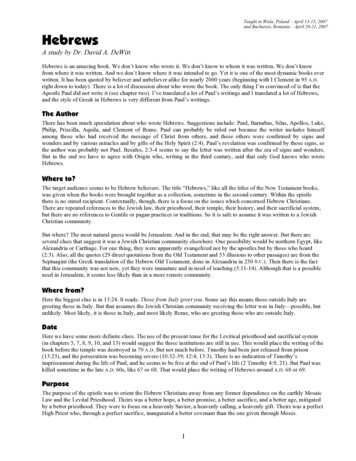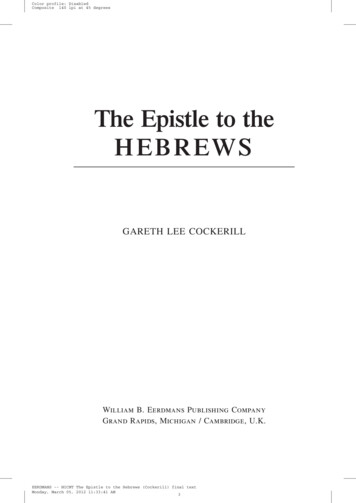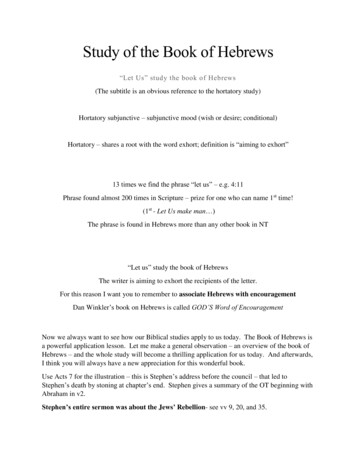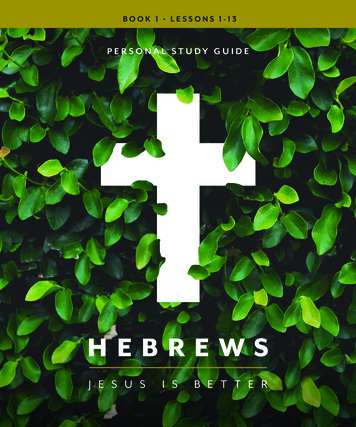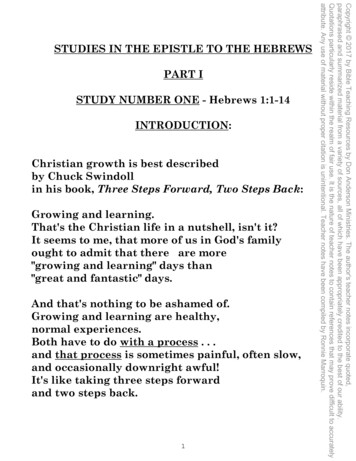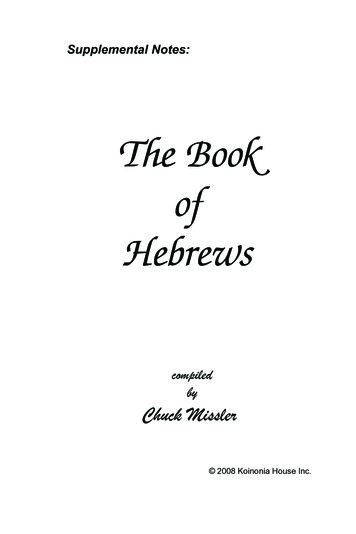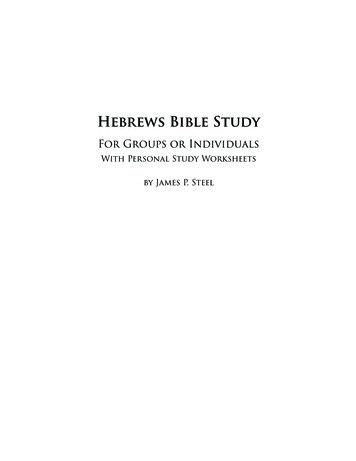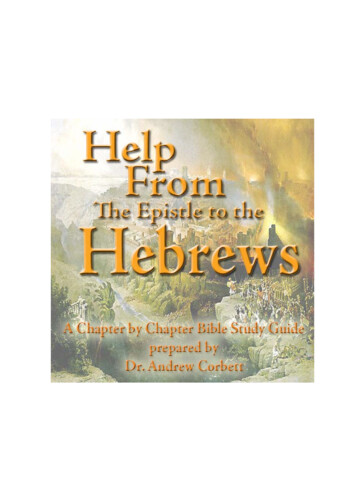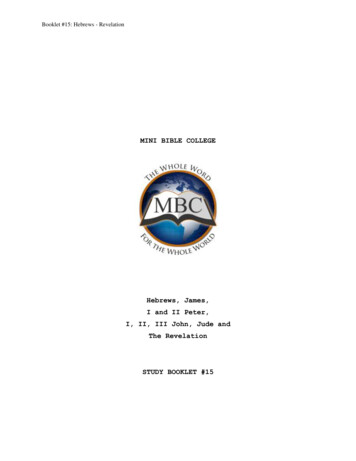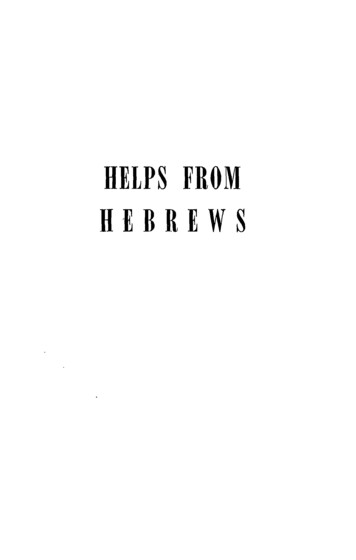
Transcription
HELPS FROMHBBREWS
The Bible Study Textbook SeriesNEW TESTAMENTPeriod and The GospelsThe Gospel of MatthewIn Four VolumesBy Harold FowlerThe Gospel of MarkBy B. W. Johnsonand Don DeWeltThe Gospel of LukeBy T. R. AppleburyThe Gospel of JohnBy Paul T. ButlerActs Made ActualBy Don DeWeltRomans RealizedBy Don DeWeltStudies in CorinthiansBy T R AppleburyGuidance From GalatiansBy Don Earl BoatmanThe Glorioub Church(Ephesians)By Wilbur FieldsPhilippians - ColossiansPhilemonBy Wilbur FieldsThinking ThroughThessaloniansBy Wilbur FieldsHelps From HebrewsBy Don Earl BoatmanJames 4 JudeBy Don FreamPaul’s LettersTo Timothy 4 TitusBY Don DeWeltILettersFromPeterBy BruceOberstIIIIHerehy We Know(I-11-Ill John)By Clinton GillIThe Seer, The Saviour, andThe Saved (Revelation)By James StraussI1OLD TESTAMENTO.T. 4 HistoryBy William Smithand Wilbur FieldsGenesisIn Four VolumesBy C. C. CrawfordExploring ExodusBy Wilbur FieldsLeviticusBy Don DeWeltNumbersBy Brant Lee DotyDeuteronomyBy Bruce OberstJoshua - JudgesRuthBy w, w. WinterI & II SamuelBy W. W. Winter14 I I KingsBy James E. SmithI & I1 ChroniclesBy Robert E. BlackIPsalmsIn Two VolumesBy J. B. RotherhamBy Paul T. ButlerIINehemiah& EstherBy Ruben Ratzlaff& Paul T. ButlerProverbsBy Donald HuntJeremiah andLamentationsBy James E. SmithIThe Shattering ofBziFi‘sJE:?ssIEcclesiastes and Song ofSolomon - By R. J . Kidwelland Don DeWelt
BIBLE S T U D Y T E X T B O O KHELPS FROMHEBREWSA NEWCommentaryWorkbookTeaching ManualDON EARL BOATMANPresident ofOmrh Bible CollegeJoplin, MissouriParaphrase by JAMES MACKNIGHTSiriirinary byT.R. AppleburyCollege Press, Joplin, Missouri
Copyright 1960Don Earl BoatmanFirst Printing - June 1960Second Printing - May 1963Third Printing - December 1969Fourth Printing - October 1974Fifth Printing - October 1979Sixth Printing-May 1984Drawings by Daniel DeWeltafter Horace KnowlesISBN 0-89900.044-4
DEDICATION
HELPS PROM HEBREWSCONTENTS AND ANALYTICAL OUTLINEOF THE EPISTLE TO THE HEBREWSPART O N ET m SUPERIORITYOF CIIRISTAS TIIE FOUNDEROF CITRISTIANITY1 :1-4 :13 . 14I, H e is superior to tlie prophets* 1 :1-3A, I l e is tlie complete and fi7ial Revelatioii of God 1 :1, 2a.B. He is the Soli of God 1 :2b, 3II. I-Ie is superior to tlie angels 1 :4-2 :18iz, In iiaiiie : “My Son” 1 :4,513, In worship : “Worship Him.” 1 :G, 7C. In1.2,3.universal rule 1:8-2:4Because of character aiid creation 8-12Served by angels 13, 14Ilence, the certainty of punishment tothose who neglected God’s Revelatioiithrough His Soil is shown 2:l-4D. In recoveriiig iiiaii’s doiiiinioii of tlie earth 2 5-181. Origiiial doiiiiiiioii of the earth by God’speople was lost through sin. This dominionis to be restored through Christ, (cf. Geii.1 :28) 5-92, The iiecessity of Christ becoiiiiiig a liuiiiaiibeing in order to accoiiiplish this 2:lO-18T o demonstrate His poher over Satan 10-15b. To sympathize with iiieii through experience 16-18111. Ile is superior to Moses 3 :1-4 !13A. The comparison of Jesus sild Moses with respectto greatiiess aiid glory 3 :1-6B. Wariiiiigs aiid exhortations with respect ‘topilgriiiiage 7-191. Israel’s. (cf. Num. 13 sild 14) 7-112, Ours 12-19C. Wariiiiig aiid exhortation in respect to rest :promises uiider Moses aiid ChiAis’t4 :1-133I.
HELPS FROM HEBREWS1. Danger of losing the heavenly restthrough unbelief and rebellion 4 :1-32. This heavenly rest in type 4-8a. The seventh day 4-5b. Canaan 6-83. Conclusion froiii the above premises 9-104. Exhortations and warnings 11-13PART T W OTHESUPERIORITYI.OFCHRISTAS HIGHPRIEST4 :14-10 :39. 138Purpose of and His fitness for the priesthood 4 :14-5 :10A. The fact of Christ’s priesthood stated, and anappeal to the reader 4:14-161. Because of His greatness, “Let us hold fastour confession” 142. Because of His human experience,“Let us draw near’’ 15-16E. The office of the priesthood 5 :1-4C. Christ’s qualifications for the priesthood 5-1011. Necessity of growth in knowledge in order torealize the hope of the priesthood 5 :11-6:20A. Difficulty of explaining the priesthood because ofthe low stage of the knowledge of his readers 5 :11-14B. Exhortation to go on to perfection 6:l-3C. The awful consequences of falling away 4-8D. Encouragement 6 :9-201. T h e apostle’s hope for them 6:9-122. The example of Abraham 13-20111. Seven proofs of the superiority of Christ’spriesthood 7: 1-10:39A. H e is a Priest after a higher order than Aaron 7:l-191. As seen in Melchizedek as a type 3:l-32. As seen in Melchizedek’s greatness in hisrelation to Abraham 7 :4-103. As seen in the imperfection of theLevitical priesthood 7 :11-19B. H e is a Priest made with an oath 20-224
HELPS FROM HEBREWSC . He is ail titichangeable Priest 23-25D, H e is a sinless Priest 26-28E, He is a Priest of a better covenant 8:l-131, Officiates in the true tabernacle, ofwhich tlie earthly was a type 1-52, Is a Mediator of a new coveiiaiit 8:6-13li‘, I-Je is a Priest in a better tabernacle 9:l-281, Tlie old tabernacle and its imperfect services 9 :1-102, Tlie superiority of Christ’s ministry intlie heavenly tabernacle 11-143, Tlie effectiveness of the new covenantbased upon the death of Christ 15-224, Necessity aiid adequalicy of tliebetter sacrifice 23-28G. He is a Priest of a better sacrifice 1O:l-391. Tlie impossibility of the Mosaicsacrifice to take away silis 1-42. Tlie efficacious and final sacrifice of Christ 5-103. Finality of Christ’s priestly ministration 11-144. Finality of Christ’s sacrificeconfirmed by prophecy 15-185. Exhortation hased oil tlie priesthood of Christ 19-39PART T H R E ET T NATURE,EDEVELOPMENT AND DUTIESOF PAITI-I11: 1-13:25 .I.Tlie nature of faith 11 :1-3A. Defiiiitioii 11 :113, Illustration 11 :2, 311. Progressive development of faith duringPatriarchal and Mosiac dispeiisatioiis 11 :4-40A. Tlie aiitediluviaii : faith in God 11 :4-713. The patriarchal: faith in God,plus faith in His promises 8-27C. Israelitish nation : faith in God’spromises of tlie coming Messiah 28-405343
HELPS FROM HEBREWS111. The perfect and final faith of theChristian dispensation 12 :1-29A. Jesus, the Attthor and Perfecter of our faith 1-3B. Perils threatening the life of faith 1-171. Failure to respond to chastening 4-132. Falling short of the grace of God 14-17C. The nature of the old covenant incontrast with that of the new 18-241. The terror of the old 18-212. The mercy of the new 22-24D. Warning 12 :25-29IV. Final exhortation regarding duties pertainingto the truth 13 :1-25A. Social duties 1-7E. Doctrine and worship 8-16C. Obedience to elders 17D. Request for prayers 18-19E. Prayer for them 20-21F. Exhortation 22G. Information concerning Timothy 23H. Salutation 24I. Benediction 256
1) ItEFACEIt is iiiy sincere hope that Pvenchiirg a i d Tenchiiig Helpsfrum H e b r e w s will iiideed lie to many what tlie title suggests.The verse-by-verse coiiinientary, given in outliiie form, slioulclprove useful both in tlie classroom and in the pulpit. In additionto the exegetical analysis of the book of Hebrews, a greatiiuiiiber of expository seriiioii outlines have been correlated intothe coiiiiiieiits,Deiiig very zealous for expository preaching, I have usedthis approacli often in the classroom of Minnesota Bible Collegewhere I formerly taught, and iiiore recently in Ozarlc BibleCollege.With siticere gratitude tlie author wishes to express appreciation to iiiaiiy friends whose work helped to make this boolcpossible,The outline for tlie book of Hebre\ys was gleaned froinProfessor Victor Hoven’s classroom lectures in Eugeiie BibleCollege.It is an honor to have Professor Ralph Applebury contributehis chapter suiiiiiiaries.Esther (Mrs. Daniel) Burris volunteered to type aacl iiiiiiieograph iiiy notes iiialiing them available to my studeiits while .Iwas teaching several years ago in RTiiiiiesota Bible College.Edeaiia White, a studeiit i,ii Ozarl; Bible College, preparedmy class discussioii questions, incorporating them into theiiiaiius cript .Professor Doli DeWelt recently urged’iiie to iiialce tlie notesavailable for this book, aiid with the assistance of ProfessorWoodrow Phillips planned for its production.Marjorie (Mrs. Woodrow) Phillips did the proof reading,aiid has contributed much to the origiiial manuscript with herability to improve seiiteiice structure.I believe this book will prove to be very helpful to those whodesire a practical application to life from the Word of God. Onlyolie Book is inspired, aiid as I have prepared these notes I havesotight diligently to teach and to write in full accord with tlieIj411 of God as fouiid in His I3ook.Doli Earl Boatman7
INTRODUCTIONI do iiot believe there is a textbook .in print, or an older oiiewhich may be reprinted, which deals with tlie book of I-Iebrewsiiiore adecluately and accurately than this, one.In the first place, Don Earl Boatiiiaii, president of Ozarlt BibleCollege, believes that God - through His Holy Spirit is theultimate author of I-lebrews, aiid of all tlie Bible. Therefore,Helps fronr Hebrews is a labor of love, periiieated by reverenceand faith.Following a rich educatioiial preparation and several yearsof successful preaching ministry, the author became a Biblecollege teacher. Assigned tlie class in Hebrews, he approachedit with the most thoroughgoing preparation possible - as he didall of liis classes. Then, each year was made the occasion andopportunity for further research a i d prayerful meditation.The present voluiiie is the outgrowth of mimeographed classnotes, which, in turn, were the outgrowth of this teaching experience. For several years, wheii I have had occasion to restudysome section of I-Iebrews, these class notes have liad high priority;iiiioiig m y reference materials. I have found them most helpful.I anticipate for Helps f o wHebrews an enthusiastic receptioii a i d a widespread aiid long continued use. I t is sufficieiitlyscholarly aiid complete to be higlily acceptable as a college textbook. As do all of the College Press - Bible Study TextbookClub publications, it incorporates several features which niake itespecially valuable for such use.The siiii1ilicit)r of the book, together with its thoughtfulquestions aiid other testbook techniques will iiialte it quite practical for study groups in tlie local church.Every preacher, elder, deacon, Bible Scliool teacher - infact, every Bible student - will want to give it a place aiiioiig liis“easiest to reach” :uid “iiiost freqttently to be used” reference andstudy volumes. L\ncl tlie fact that it is prepared with textbookuse particularly in mind iiialces its factual coiiteiit the iiioreeasily accessible, :uid ;idds to its suggestive aiid stiiiiulative value.Chester A. Williamson-
GENERAL INTRODUCTION T O THE EPISTLET O THE HEBREWS1, Tlze people addressed - Tlie letter to the Ilebrews wasevidently addressed to Jewish Christians who were hi dangerof apostatizing f roiii Christ sild returiiiiig to Judaism. Theywere subjected to persecution by their own race and treatedas apostates and uiicleaii because they had leit Moses aiidaccepted Christ.2, The purposc of ihe epistle,a, T o exhibit tlie uiisurpassed glory of tlie new coiiveiiaiitin contrast with tlie old.b, To exhort tlie Hebrew Christians to steadiastiiess inChrist. ci. 3 :12 ; 4 :14; 6 :4-8 ; 10 :23 ; 13 :22.3. Aiitlzorship.a. Tradition of tlie church in tlie East, wliere the epistle wasfirst received, is unanimous in ascribing authorship to theApostle Paul, as did also the couiicil of Cartliage, 397AD,,and Cleiiieiit of Alexandria, 165 to 220 A.D.4. Iiitevnal evideiice as to P a d s autlzoipslzip.a, Figures of speech are similar to those used in liis otherletters. cf. I Cor, 9 :24-25 ; Gal. 2 :2 ; 5 :7 ; Phil. 3 :13-14;I1 Tim. 4 :7-8 with Heb. 12 :1-2,b. Paul’s view of the law as expressed in liis other lettersis tlie same view expressed in Hebrews. cf. Acts 13 :39;Rom. 7 :1-6; I Cor. 9 :20-21; I1 Cor. 3 :6-13 ; Gal. 3 :16 t o4:31; Eph. 2:14-18; Col. 2:13-17 with Heb. 8:7 to 10:18.c. Tlie word “niediator” is used by Paul only. cf. Gal.3:19-20; I Tim, 2 : s with Heb. 8 : 6 ; 9:15; 12:24d. Coiiditioiis in tlie life of Paul are true to those of tliewriter of the Hebrew letter,1 ) The writer was a prisoner in Italy. Heb. 13 :19-24.2 ) Tlie writer was a friend of Timothy. Ileb. 13:23.3 ) Tlie writer asks for prayers of brethren that lie might beset free. Heb. 13:18-19.e. Tlie word “covenant” is found only seven tiiiies in theNew Testaiiient outside of Paul’s writings. Paul uses itiiiiie tiiiies in other writings. I t is used seventeen timesin I-Iebrews.f . No other writer iiivoltes grace upoii readers,5. Date.Though much is said of the worship and sacrifice in the11
HELPS FROM HEBREWStemple, there is an entire absence of any intiiiiation thatthe temple had been destroyed. cf. 8 :4; 10 :11. Since thetemple was destroyed in 4.D. 70, the letter must havebeen written before that date. From 13:24it seems tohave been written in Italy.6. Place (supposition),According to the references in 13:24 to the prayers, itmust have been written during his first imprisonmentfrom 61-63 A.D. in Rome, Italy.ANALYSIS :1. The great propositioa of this epistle is: The superiority ofChristianity to Judaism is seen in its Founder aiid Medintor,Jesus Christ.2. The Book Has Three Divisions.Part I. The superiority of Christ as Founder of Christianity - 1 :1-4:13.Part 11. The superiority of Christ as High Priest-4 :14-10:39.Part 111. The nature, development aiid duties of faith11:1-13:253. In this letter, Christ is shozplii to be superior t o : Prophets1 :l-3;Angels 1 :4-2:18;Moses 3:l-4:13.4. Alexander Campbell’s estimation of this letter and also ofRomans :“The epistle to Roiiians and Hebrews containsthe most coiiipreheiisive aiid complete expositionof all that enters into Christian faith and worshipever spoken or written.”QUESTIONS ON THE OUTLINEI. On the introductiow.1. Is the epistle addressed to a specific area, or to a person?2. What nationality seems to be in the niind of the author?3, What can we judge their spiritual condition to be?4. What seems to be the purpose of the epistle?5 . What bearing has traditio11 upon ascribing the authorshipto Paul?6. What authorities ascribe Paul’s authorship ?7. Who else is suggested?8. VJhat is meant by “internal evidence of authorship”?12
HELPS FROM HEBREWS9, Wliat is the evideiice of internal authorship in regard toligurcs of speech ?10, If you feel that Paul wrote this letter, how do you explainl-leb, 2 :3 ? (See my notes.)11, Do you eel that Paul’s view of the law is a strong argti111ent for authorship ? Why ?12, Explain the value of the argument from the word“iiiediator”.13, Are the conditions in the life of the author true to Paul?Name three.14, “A prisoner in Italy” is suggested as one condition. Couldthis be true of others ?15, Could others have been a friend of Timothy?16, Do you feel that his prayer for deliverance to be with themcarrjes much evidence ?17. Was Paul primarily a missionary to the Jews, thereforemalting this a strong argument ?18. Tell of the use of the word “covenant” in New Testamentwritings.19. What can be said of the date of the authorship?20, What is the evidence for the place where it was written?21. Do we have any other evidence froin other epistles that Paulniay have been the author ?22. What does the salutation or benedictioii at the close iiidicqteas to authorship ?11, Oit tlze aiialysis.1, What seems to be the great proposition of the book?2. Is the entire book given over to this?3. If not, what is the aatpre of the balance of the book?4, Name the three divisions of the book.a. Superiority of Christ as the Founder of Christianity1:I-4:13.b, Superiority of Christ as High Priest -4 :14-10 :39.c. Nature, development and duties of faith - 11;1-13:25.5. According to 2his lettew, to whom is Christ superior?a. Prophets1 :1-3.b, Angels - 1 :4-2 :18.c, Moses - 3 :1-4 :13.0.Y--13
1 :1, 2HELPS FROM HEBRElt’SPART ONETHESUPERIORITYOF CHRISTAS THE FOUNDEROF CHRISTIANITY111-4:13.I. He is superior to the proplzcts. 1 :1-3.A. He is the cowaplete and f i n d revelatiorb of God, 1 :1, 2a.Text1 :1-2a1 God, having of old time spoken unto the fathers in theprophets by divers portions and in divers iii;miers, 2a hath atthe end of these days spoken unto us in His Son , , .Parnpbvnse1 The same God, who in sundry parts and in divers nianiiersanciently revealed His will to the fathers of the Jewish nationby the prophets, Enoch, ( J tide, ver. 14), Moses, Samuel. David,Isaiah, etc.2a Hath in these last days of the Mosaic dispensation spokenthe gospel to nianltind, all at once and after one maiiner . . .CommeiztGodThe book begins with an assumption of God’s esisteiice. LikeGenesis, it makes no attempt to prove the existence of God. ThePsalmist said that fools do not believe in God. cf. 1 4 : l ; 53:l.The author of Hebrews must have felt the same way.This wonderful God of niaii is not appreciated, so ;L briefstudy of Him is in order. This study is far from exhaustiveh i t is practical :a. The Being of God:1) H e is Spirit - John 4 :24.2 ) H e is Eternal- Romans 16:26; I1 Peter 3 9 .3 ) H e is Living- Matt. 22:32; 16:16.4) le is One - Rom. 16.27; I Tim. 1 :17; Jude 25.5 ) H e is Ultimate (alpha and omega) - Rev. 21 :6.b. The Character of God:1) Oiiiiiipoteiit - all-powerful - almighty - Rev. 19:6; Rom.13 :1.2) Oiiiiiiscient - all-wise - lcnoweth all things - Rom. 16 :27 ;Eph. 3 :10 - manifold wisdom.3) Holy-John1 7 : l l ; Rev. 4%; 6:lO.14
HELP S FR0 M HE33 REW S1 :14) Righteous-- Joh11 17 :25 ; R/1att, G :33 ; Phil. 3 :9.5) Good - R o u 2. :4 ; Jdtlltc 18 :19.6) Kind - Titus 3 :4,7 ) nlerciful- Roiii, 12 :1 ; I1 Cor. 1 :3 ; Luke G:3G,8) JUS - Gal. 3 3; Rom. 3 :2G.9) Loving - Joliii 1G :27; I1 Cor, 13 :11 ; 11 Tlies. 2 :1G.c. Ti1 relatioiiship to Ilie world:1) This is of primary iinportance, for God has iiot been farremoved iroiii iiiaii, but has sought to wiii iiiaii to Iliiiiself,2) Below are listed some phases of His relatioiiship :a) Omnipresent :Acts 17 :24-25 - “dwelletli not in temples - I ’Acts 17 :28 - “in Hiin we live - ”b) Creator:Acts 17 :24 - “the God that made the world”ndarlc 13 :19,c) Sovereign - Ruler, Lord, Monarch :Acts 17 :24 -- “He beiiig Lord of earth - ”d ) Savior:Luke 1 :47 - “in God iiiy Savior,”1 Tim, 2 :3 - ‘(in the sight of God our Savior - ”- Jude 25 - “God our Savior.”e ) Revealer:Phil. 3 :15 - “God shall reveal this uiito you - I ’I Cor. 2 :10 - “God revealed them tinto us - I ’Rom. 1 :17 - “therein is revealed lznviiig of oldeii t h e spokenThis refers to God’s contact with man from the very begiiining. God has always spolteii to maii:a. In the patriarchal time God spolte face to face :1) To Adam,2) To Noah.3) To Abraliam, Isaac and Jacob.b. H e spoke to iiiaii through prophets in a great attempt to wiiiman :1) Moses the lawgiver was a mighty voice for God.2) The iiiajor and iiiiiior prophets had a iiiajor message.Some doubt that God spolte. Aside froin the Word that saysI l e did, it s e e m lilcely that 1% would.’I15
1 :1HELPS F R O M HEBREWSa. If H e codd, but would not, H e would not be a just andrighteous God; therefore, H e would not be worthy ofworship.b. If He would but could not, then H e would be weaker thanman, aiid therefore, unworthy of worship.spokevl w t o the fathersWho is referred to?a. Possibly the patriarchal fathers are included.b. No doubt the Jewish race as a whole under the Mosaic lawshould be considered as iiicluded.X problem with the patriarchal consideration is that he says“uiito the fathers in the prophets.”a. The prophets appeared during the Mosaic clispeiisation.b. However, tlie word “prophet“ is not limited to the idea offoretelling of events.c. Prophecy means “to tell,” aiid on occasions the patriarchsiiiay have served as prophets to their generation.ina.b.a.b.a.b.a.b.c.prophetsThe ineaiiiiig of the word:One who speaks for another - a “forth-teller.”Foretelling of the coming of Christ was by 110 iiieaiis theironly task.The prophets are divided into two groups :Major prophets - Isaiah, Jeremiah, Ezekiel, and Daniel.Minor prophets -The iiarnes of the last twelve books of theOld Testament are the minor prophets.There are others who are considered prophets:Moses - Deut. 18 :15.Aaron - E X O L7I:1S- “Aaron shall be thy prophet.”The preaching of the prophets may be geiierally sunimarizedunder three phases :Judgiiients upoii kingdoms.The coiiiiiig kingdom.The King of kings.tlieiuz divers portioiasThis suggests that God’s revelations to liiaii have been indifferent dispensations :a. Covenants of faith with the patriarchs were made in thePatriarchal or Starlight Dispensation.16
HE Lrs FR oM JIEB REW s1:111, Coveiiaiits with Moses were made in tlie MoonlightDispensation.1) During this period, the prophets gave further light to thepeople of the day.2) The prophets also eiiliglitetied iiien about tlie Sunlight Dispciisation to follow,3) John the Baptist removed the filial clouds.God spoke more fully followiiig these two dispensations withtwo others:a, The revelation of Jesus is the Sunlight Dispeiisatioii.11. The message o f tlie apostles is tlie Iloly Spirit Dispensation.The “divers portion”, then, may be called progressive revelation, The portions put together iiialce Qiie book.a. The portions have a unity when read as oiie book :1) Its history is a unit.a ) A history of tlie past.11) Teaching for a satisfactory present.c) A prophecy of the future.2) n h l 5 salvation is in it:a ) A scarlet thread runs throughout all the Word.b) Blood atoiiemeiit is tlie theme that ties the MTord togetherfrom Genesis to Revelation,3) A Person i s there, although revealed in different portioiis :a) Geii. 3 :15 speaks of Hiiii bruising the serpent’s bead,b ) Isaiah 53 speaks of Him being bruised.c) Revelatioii pictures Ilim destroying all wicltediiess andrewarding righteousness.4) A ltiiigdom is there Ia ) A prophetic lciiigdoiii Dan. 2 :44,11) A present ltiiigdoiii - Matt. 16 :18.c) A world-wide victorious lciiigdom - Matt. 24 :44;Rev. 11 :15- “ltiiigdoiii of tlie world is becoiiie the ICingdom of ourLord.”b. Since Christ gave credence to the portions, tlie critic mustdestroy Christ before lie can destroy the Old Testament. cf.Luke 24 :44 ; Matt. 12 :39-41 ; 16 :4.l-iiadiveys man aevsThis suggests that God has used various methods to makekiiowii I-Iis message :17
1 :2HELPS FROM HEBREWSa. H e spoke with a voice:Exodus 24:4-‘“all the words which Jehovah hath spokenwill we do - ”Isaiah 38 :4 - “Then came the word of the Lord to Isaiah,saying - ”b. H e wrote with His fingers:Dan. 5 :5 - Belshazzar saw the handwriti’ng on the wall.Ex. 31 :18 -The law was written by the fingers of God.c. H e spoke in action, demonstrating his power:1) Miracles were of several kinds:a ) Burning bush - Ex, 3 :2.b) Daniel in the lions’ den-Dan. 6:22.c) Walls of Jerico fell -Joshua 6 :20.d ) Thundering and lightning when the law was given - Ex.20 :18.2) Temple veil rent in twain - Matt. 27 :51. This spoke of theending of the earthly Holy of Holies.3 ) Victory in war for his people showed that righteousness mustprevail.a ) Gideon’s victory - Heb. 11 :32 and Judges 7:22b) Egyptians defeated in the Ked Sea.cl. H e spoke in dreams and visions:1) Daniel 2 :I - Nebuchadnezzar’s dream and interpretation byDaniel in 2 :17-49.2) Joseph interprets dreams of fellow prisoners in Gen. 40.3) Joseph’s dream in Gen. 37.4) See Hosea 12:lO.Romans 1 :4is proof that “spoke” may refer t o more thanvocal words :cf . Ps. 19 :2 - “day unto day uttereth speech.”c f . Rom. 1 :20 - “even His everlasting power and divinity.”hath at the end of these daysWhat days ?a. The days of the prophets just referred to.b. The prophets’ days seemed closed for about 400 years afterMalachi, but John broke the silence.C. These days may refer to the end of the Jewish age, whichwas a prophetic age.spokeit m t o us in His SonHow did God speak through Him ?18
1 :2HELPS FROM HEBREWSa. Not always vocally.1) Christ’s compassion and love spoke,2 ) Christ’s resurrection spoke. cf, Rom, 1 :4- “who wasdeclared to be the Son of God with power ”In Christ’s voice God spoke:John 8 :28- “but as the Father taught Me, I speak thesethings ,”John 12:49- “For I spalte not from Myself but the Fatherthat sent Me, He hath given Me a commandment what Ishould say and what I should speak.”John 14:lO- “the words I speak, 1 speak not of Myself - ”-Study Questions1. Does the book of Hebrews begin with the word “God”?Does the original Greek manuscript begin this way ?2. In what way is Hebrews like Genesis?3. Name the three divisions iii my outline about God.4. Tell of the being of God.5 . Tell of the character of God.6. What can be said about God’s relationship to the world ?7. What is meant by “olden times’’?8. In patriarchal times, how did H e speak?9. What would you think about God if H e could but wouldn’tspeak to m a n ?10. What would you say about God if H e would but couldn’tspeak to man?11. Who is meant by the term “fathers”?12. When did prophets first come into Bible history?13. Did prophets speak to the patriarchs? If not, can “fathers”refer to them?14. What ig the responsibility of a prophet?15. Name a prophet who spoke to Abraham.16. Into what two groups are the prophets divided?17. Explain the term, “divers portions”,18. What is meant by “different dispensations” 719. Explain the expression, “progressive revelation”.20. Do these portions comprise a unit?21. Do you see a theme running through all the revelationof God?22. Does Christ give credence to the Old Testament?23. What were the ways God spoke?19
1 :2b, 3HELPS FROM HEBREWS24. Tell of some actions of God that revealed something aboutHim.25. What message was spoken by the temple veil being rent?26. What was spoken concerning God in His helping the peoplein war ?27. Name some dreams in which God spoke.28. Name some visions in which God spoke.29. Are all of God’s messages vocal?30. What is meant by “end of these days”?31. What days are referred t o ?32. How did God speak through Christ?33. Did Christ claim to speak for God?B. H e is the Soit of God. 1 :2b, 3.Text1 :2b-32b . . . whom H e appointed heir of all things, through whom alsoH e made the worlds ; 3 W h o being the effulgence of His glory,and the very image of His substance, and upholcling all thingsby the word of His power, when H e had macle purification ofsins, sat clown on the right hand of the Majesty on high;Paraphrase2b . . . by His Son made flesh whom H e constituted heir of allthings ; through whom also H e made the worlds.3 This great personage, even in His incarnate state, being a’neffulgence of His Father’s glory, and an exact image of His substance, and upholding all things (namely, the worlds, ver. 2.) byHis powerful command, when H e had made atonement for oursins by the sacrifice of Himself, and not of beasts, sat down atthe right hand of the manifestation of the divine presence in thehighest heavens, by invitation from God, whol thereby declaredHis ministrations as a priest both acceptable and effectual.Commentin His SonThis Sonship is in a unique sense:a. H e is the only one of His kind.b. H e is not a son-but the Son.His Sonship was established by many proofs:a. H e is the Son in the parable of the husbandman.Luke 20:9-18; cf. Matt. 11:25.20
HELPS FROM HEBREWS1 :2b,3b, Jesus claimed to be the Son.John 14 :2 - “in My Father’s house.”John 4 :26 - “1 am He - ”c, Son -as seen in His miracles : John 20:30-31.d, Son -as seen in His superior teaching,John 7 :46 “never man so spake.”e. Son --as seen in His superior life :Luke 23 :4- Pilate : “I find no fault ”Heb, 4:14-“Ilaving then a great high priest , , , the Sonof G o d , , , ”John 18 :46- “which of you convicteth Me of sin , ’’f . Son - as seen in His resurrection:Rom. 1:4; Acts 17:30-31.g, Son-as seen in the acclamation of God:Matt, 3 :17 - at His baptism.Matt, 17 :1-8 at His transfiguration.--.-Whoin He appointed heir of all thingsThe word “heir” suggests something to inherit. What was i t ?a. Ail excellent name. Heb. 1:4. cf. Phil, 2 5-11,b, Lordship, Acts 2:36. Matt, 28;18.c. Power and judgment. John 5 :22- “given judgment untothe Son.”throMgla whom also He made the worldsChrist was present in creation:John 1 :3 - “all things were made through Him . . ”Gen. 1:26-‘“Let us make man in Our image, after O wlikeness , . ”.the worldsThe Greek word here translated, “worlds”, is disputed bytranslators.a. The footnote is “ages”.b. The singular form has three meanings :1) Endless duration.2) Any age or period.3) Anything that lives or exists,We may assume that it refers to the processes in each age bywhich God is bringing to pass His great purposes.who being the efulgwce of His gloryThe word ”effulgence” is also translated “brightness”,21
1 :3HELPS FROM HEBREWSa. This word appears only once in the New Testament.h. “Effulgence” means a reflected splendor.Jesus made it plain that those who saw Him could say thatthey had seen the Father.John 14%-9; 1 4 : l l ; 17:21.They saw the Father only as they saw His qualities in Christ.a. John 1 :18 - “No man hath seen God at any time.”h. A11 that God is, has been expressed in Jesus.nrzd the verya.1)2)11.c.a.b.c.1)2)cl.iidiialngeof His substanceThis makes Him deity, which should be theological enoughfor us !“Iniage” means “impress”.The word in the Greek is chnraktei.In the primary sense, it denotes the instrument used in engraving or carving.The whole expression, “the very image of His substance”, isused to set forth the dignity of Christ, in order to build upour faith.Calvin says, “He is called the ‘impress of His substance’,because the majesty of the Father is hidden until it showsitself impressed as it were on his image. They who overlookthis connection and carry their philosophy higher, wearythemselves to no purpose, for they do, not understand thedesign of the Apostle; for it was not his object
HELPS FROM HEBREWS C. He is ail titichangeable Priest 23-25 D, He is a sinless Priest 26-28 E, He is a Priest of a better covenant 8:l-13 1, Officiates in the true tabernacle, of which tlie earthly was a type 1-5 2, Is a Mediator of new coveiiaiit 8:6-13 li‘, I-Je is a Priest in better tabernacle 9:l-28
